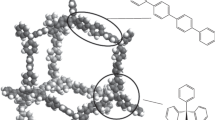Abstract
Disubstituted polyacetylene poly(4-methyl-2-pentyne) (PMP) exhibits one of the highest levels of gas/vapor permeability and selectivity of C3+ recovery from mixtures with permanent gases among known polymers. In this study, semi-interpenetrating networks based on compatible mixtures of PMP and thermally crosslinked polyethyleneimine (PEI) have been obtained to enhance the resistance of PMP to organic solvents. Investigation of the phase equilibrium of PMP and PEI mixtures by optical interferometry has revealed that PMP dissolves up to 30 vol % PEI at room temperature. The fact of thermal crosslinking of PEI is confirmed by IR data. The influence of the proportion of crosslinked PEI on the gas permeability, solubility, and swelling in organic solvents of the films prepared from PMP mixtures with PEI has been examined. Having the PEI content higher than 20 vol %, the films are resistant to organic solvents for at least 14 days. Moreover, with an increase in the proportion of PEI, the degree of swelling of the films is substantially reduced. The increase in stability can be explained by the retention of PMP macromolecules in the crosslinked PEI matrix, which probably reduces the swelling of the films and impedes the extraction of linear PMP macromolecules from the polymer network. The ideal O2/N2, CO2/N2, and CO2/CH4 selectivities increase with a growth in the PEI proportion.






Similar content being viewed by others
REFERENCES
K. Nagai, T. Masuda, T. Nakagawa, et al., Prog. Polym. Sci. 26, 721 (2001).
R. Srinivasan, S. R. Auvil, and P. M. Burban, J. Membr. Sci. 86, 67 (1994).
T. C. Merckel, R. P. Gupta, B. S. Turk, and B. D. Freeman, J. Membr. Sci. 191, 85 (2001).
A. Morisato and I. Pinnau, J. Membr. Sci. 121, 243 (1996).
T. C. Merkel, B. D. Freeman, R. J. Spontak, et al., Chem. Mater. 15, 109 (2003).
T. C. Merkel, B. D. Freeman, R. J. Spontak, et al., Science 296 (5567), 519 (2002).
W. Yave, S. Shishatskiy, V. Abetz, et al., Macromol. Chem. Phys. 208, 2412 (2007).
V. S. Khotimsky, S. M. Matson, E. G. Litvinova, et al., Polym. Sci., Ser. A. 45, 740 (2003).
A. Morisato and I. Pinnau, J. Membr. Sci. 121, 243 (1996).
R. W. Baker, Ind. Eng. Chem. Res. 41, 1393 (2002).
S. L. Doo, S. J. Dae, H. K. Tae, and C. K. Sung, J. Membr. Sci. 60, 233 (1991).
D. S. Lee, W. K. Kang, J. H. An, and S. C. Kim, J. Membr. Sci. 75, 15 (1992).
B.-Y. Lim and S.-C. Kim, J. Membr. Sci. 209, 293 (2002).
J. Aleman, A. V. Chadwick, J. He, et al., Pure Appl. Chem. 79, 1801 (2007).
L. Chikh, V. Delhorbe, and O. Fichet, J. Membr. Sci. 368, 1 (2011).
S. Saimani and A. Kumar, J. Appl. Polym. Sci. 110, 3606 (2008).
J. R. Nair, M. Destro, F. Bella, and G. B. Appetecchi, J. Power Sources 306, 258 (2016).
J. Kurdi and A. Kumar, J. Membr. Sci. 280, 234 (2006).
S. Saimani, M. M. Dal-Cin, A. Kumar, and D. M. Kingston, J. Membr. Sci. 362, 353 (2010).
C. Zhang, W. Zhang, H. Gao, et al., J. Membr. Sci. 528, 72 (2017).
J. Kurdi and A. Kumar, Sep. Purif. Technol. 53, 301 (2007).
J. Kurdi and A. Kumar, J. Membr. Sci. 280, 234 (2006).
M.-S. Kang, J. H. Kim, J. Won, et al., J. Membr. Sci. 247, 127 (2005).
X. Wu, G. He, S. Gu, et al., J. Membr. Sci. 295, 80 (2007).
J. Reale, Jr., US Patent No. 5032278 (1991).
A. A. Surovtsev, N. V. Petrushanskaya, O. P. Karpov, et al., RU Patent No. 2228323 (2004).
A. Ya. Malkin and A. E. Chalykh, Diffusion and Viscosity of Polymers: Measurement Techniques (Khimiya, Moscow, 1979) [in Russian].
V. Makarova and V. Kulichikhin, Interferometry: Research and Applications in Science and Technology, Ed. by I. Padron (InTech, Rijeka, 2012), ch. 20.
M. M. Feldstein, T. I. Kiseleva, G. N. Bondarenko, et al., J. Appl. Polym. Sci. 112, 1142 (2009).
B. V. Ioffe, Refractometric Techniques in Chemistry (Khimiya, Leningrad, 1974) [in Russian].
Q. Lu, J. Yang, W. Lu, J. Wang, Y. Nuli, Electrochim. Acta 152, 489 (2015).
F. Tran-Van, L. Beouch, F. Vidal, et al., Electrochim. Acta 53, 4336 (2008).
E. Cznotka, S. Jeschke, P. Vettikuzha, and H.-D. Wiemhöfer, Solid States Ionics 274, 55 (2015).
D. He, D. W. Kim, J. S. Park, et al., J. Power Sources 244, 170 (2013).
S. Kalapala and A. J. Easteal, J. Power Sources 147, 256 (2005).
H.-J. Ha, E.-H. Kil, Y. H. Kwon, et al., Energy Environ. Sci. 5, 6491 (2012).
ACKNOWLEDGMENTS
The authors are grateful to G.N. Bondarenko for assistance in measuring IR spectra.
The work was supported by the Federal Agency of Science Institutions of Russia within the framework of the State task to the Topchiev Institute of Petrochemical Synthesis, Russian Academy of Sciences.
Author information
Authors and Affiliations
Corresponding author
Additional information
Translated by S. Zatonsky
Rights and permissions
About this article
Cite this article
Matson, S.M., Litvinova, E.G. & Khotimskiy, V.S. Membrane Materials with Semi-Interpenetrating Networks Based on Poly(4-methyl-2-pentyne) and Polyethyleneimine. Pet. Chem. 58, 934–940 (2018). https://doi.org/10.1134/S0965544118110063
Received:
Published:
Issue Date:
DOI: https://doi.org/10.1134/S0965544118110063



